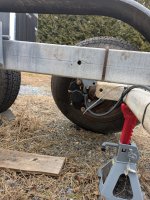But it did not bleed like the port side. Port side I got real good stream. Starboard side it took 10x as long to get the stream into the collection reservoir.
Also when I push the actuator to engage the brakes the port side would release but the starboard side would still be locked and slowly release after a while or if I hit the bleeder to release it.
Lots of good info here but I am going to suggest two things still warrant looking at.
1st with respect to bleeding using the vacuum device > follow the same protocol of putting the closed end of the wrench on the bleeder screw prior to hooking up the hose, turn on the vacuum device and only open the screw no more then ¼ turn. As mentioned above air can get sucked in around the bleeder screws threads giving a false indication of air in the line. And by putting the closed end of the wrench on the screw you have better control and a visual of the ¼ turn opening (vs using the open end, having it slip off and then having the hose itself causing the value to open more as screw is real easy to turn (or should be)). And a ¼ turn (or less) should help preclude sucking in air. Sucking air thru the threads of the bleeder screw is not an issue with pressure bleeding.
2nd that stbd side is not ‘releasing’.
I strongly recommend further investigation. The piston of a disc brake caliper is retracted by two things: (1) the square “O-Ring” sealing the piston actually flexes when the brakes are applied and once pressure is relieved, it relaxes back to its normal shape pulling in the piston and (2) the play in the wheel bearing allows ever so slight movement of the rotor > a very slight rocking back and forth (as if you grabbed the wheel at top and bottom and push / pulled) > this play also ‘pushes’ on the pad which pushes on the piston (once the pressure is relieved). All that said, a key indicator of something wrong is when one side behaves or feels differently from the other. And this really caught my attention.
More: I am unsure if you changed out the actual hoses, reroute yes, but are they new? The concern is that you had to relieve pressure via the bleeder screw to get it to be free. That, and the issue with 10X the effort to bleed, leads me to believe you have an internally collapsed hose or some other restriction. This restriction is not allowing the pressure to bleed off AND is causing air to be sucked around the threads of the bleeder screw giving a false indication as mentioned above > i.e. the restriction is causing the fluid to not easily flow in
either direction.
While the above is my first guess, it’s also possible that the caliper is bad via one of two methods (1) the piston / seals are such that the piston does not operate as it should (ex. corroded piston, damaged seal) or the floater pins/caliper are not freely moving. But this does not account for the 10x to bleed, hence my first guess.
More More: it is my strong opinion that you need to be 100% confident your brakes are working as designed and if need be, take it somewhere to be sure. While not ideal to turn it over to others, I truly get that, but the hazards of not having proper working brakes on trailer or the tow vehicle are simply not worth it.






















